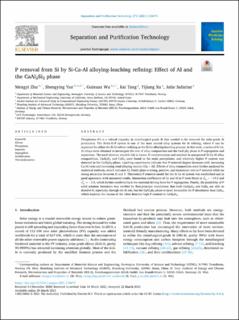| dc.contributor.author | Zhu, Mengyi | |
| dc.contributor.author | Yue, Shengying | |
| dc.contributor.author | Wu, Guixuan | |
| dc.contributor.author | Tang, Kai | |
| dc.contributor.author | Xu, Yijiang | |
| dc.contributor.author | Safarian, Jafar | |
| dc.date.accessioned | 2021-06-08T12:40:16Z | |
| dc.date.available | 2021-06-08T12:40:16Z | |
| dc.date.created | 2021-05-12T23:49:34Z | |
| dc.date.issued | 2021 | |
| dc.identifier.citation | Separation and Purification Technology. 2021, 271, . | en_US |
| dc.identifier.issn | 1383-5866 | |
| dc.identifier.uri | https://hdl.handle.net/11250/2758521 | |
| dc.description.abstract | Phosphorus (P) is a critical impurity in metallurgical-grade Si that needed to be removed for solar-grade Si production. The Si-Ca-Al-P system is one of the most crucial alloy systems for Si refining, where P can be separated by either the Si-Al solvent refining or the Si-Ca alloying-leaching process. In this work, a series of Si-Ca-Al alloys were obtained to investigate the role of alloy composition and the CaAl2Si2 phase in P segregation and separation. The used alumina crucible led to heavy Al contamination and resulted in unexpected Si-Ca-Al alloy compositions. CaAl2Si2 and CaSi2 were found as the main precipitates, and relatively higher P content was detected in the CaAl2Si2 phase. Leaching experiments indicate that P removal degree increases with increasing Ca/Al ratio and increasing total alloying amount (Ca + Al). Effects of alloy composition were further analyzed by statistical methods, which indicates Ca firmly plays a strong, positive, and monotonic role in P removal while no strong attraction between Al and P. Theoretical P removal model for the Si-Ca-Al system was established and in good agreement with measured results. Interaction coefficients of Ca and Al to P were fitted as and , which further confirms Ca is the essential driving force for P segregation. Finally, the possibility of P solid solution formation was verified by first-principle simulations that both CaAl2Si2 and CaSi2 are able to dissolve P, especially through the Si site, but the CaAl2Si2 phase is more favourable for P dissolution than CaSi2, which explains the reason of the often detected high P content in CaAl2Si2. | en_US |
| dc.language.iso | eng | en_US |
| dc.publisher | Elsevier Ltd. | en_US |
| dc.rights | Navngivelse 4.0 Internasjonal | * |
| dc.rights.uri | http://creativecommons.org/licenses/by/4.0/deed.no | * |
| dc.title | P removal from Si by Si-Ca-Al alloying-leaching refining: Effect of Al and the CaAl2Si2 phase | en_US |
| dc.type | Peer reviewed | en_US |
| dc.type | Journal article | en_US |
| dc.description.version | publishedVersion | en_US |
| dc.source.volume | 271 | en_US |
| dc.source.journal | Separation and Purification Technology | en_US |
| dc.identifier.doi | https://doi.org/10.1016/j.seppur.2021.118675 | |
| dc.identifier.cristin | 1909833 | |
| dc.description.localcode | This is an open access article distributed under the terms of the Creative Commons CC-BY license, which permits unrestricted use, distribution, and reproduction in any medium, provided the original work is properly cited. | en_US |
| dc.source.articlenumber | 118675 | en_US |
| cristin.ispublished | true | |
| cristin.fulltext | original | |
| cristin.qualitycode | 1 | |

